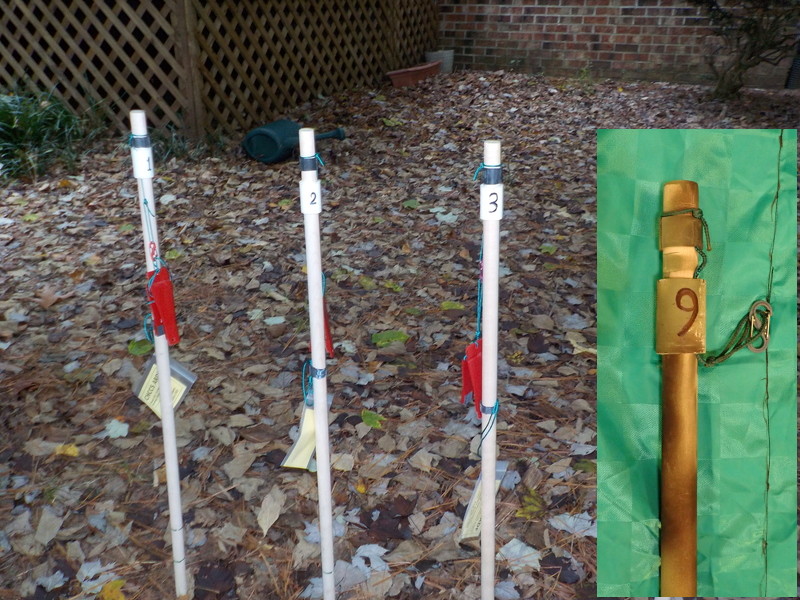2019 May 4 event update — Almost all the information here is applicable to the May 4 event. The main difference is that the May 4 event will be for beginners and will only have 6 controls rather than 10.
091. What to expect at the October 20 foxoring ARDF.
2018-10-12. Patrick & Kelly.This page describes how the Oct-20 foxoring event will be different from our usual classic ARDF events. The information is mostly for those who have been to our events in the past. For newcomers, there will be our usual class during which we will explain everything in detail.
Meeting location and times.
Park in the Municipal Drive parking lot of Carolina North Forest (CNF). We will have our usual orange/white ARDF signs to direct you. After parking, walk down the path at the end of the parking lot to our meeting place. Google maps. This is the same place we've met for the last two events. The start and finish will be next to our meeting place.
You can start on course any time from 11 AM to 2 PM. Those who have been to our events in the past can start as early as 10 AM if the equipment is all up and running, but no guarantees. As usual, we'll keep the course open until 3 PM if someone is still on course.
If you haven't been to one of our events before, please arrive around 11 AM. This will give you the time to sign in and get your equipment before class. Patrick will take a group for some on-course instruction. You are free to go searching on your own when you feel confident. If you can't make it by 11 AM, no worries. We'll still make sure all your questions are answered and you'll have a fun time searching for the foxes.
A quick run through the foxoring event.
You'll get a map with all the control points marked on it. There will be a fox close to each control point. So unlike in classic events, you'll have a good idea where each fox is before you start. But the foxo transmitters will be so weak that you won't be able to hear the foxes from the start location. You can plan your route as soon as you get your map. On course, you will orienteer to control points using the map and compass. Each control point will be centered on a feature such us a boulder or a trail crossing. So you will know when you have reached the control point by finding the feature.
As you approach the control point, you can listen for the fox. If you hear the fox before you reach the designated feature, you can go straight for it. Right next to the foxo transmitter, there will be a pole labeled with the foxo number and with the punch hanging from it. Punch your card, and go for the next fox. When you're all done, go for the homing beacon and finish.
Similarities with the classic events.
- There will be a homing beacon transmitting continuously and it will be possible to hear it over the entire course area.
- All the foxes will transmit on the same frequency and the homing beacon will transmit on a different frequency.
- You can get the foxes in any order.
- You don't have to get all the foxes but you must get back on time.
- The transmitters are in the same band (80 m). You will use the same receivers in the same way.
- The homing beacon and foxes are on two different frequencies. So when you're done finding foxes, switch frequencies and go for the homing beacon.
Differences between the classic and foxoring events.
| 80m classic | foxoring |
|---|---|
| Fox locations are not marked on the map. | Fox locations are marked with a pink circle on the map. |
| Fox transmitters can be heard over entire course area. | Fox transmitters can be heard from the circle center as marked on the map and from more than 30m away but not over entire course area. |
| There are 5 foxes. | There are 10 foxes. |
| There is a 30x30 cm orange/white orienteering flag at each fox location. You may be able to see it from 20 to 30 m away. | There is only a stick in the ground at each fox location. You will have a hard time seeing it unless you get within a few meters. |
| Each fox transmits for only one minute out of five. | Foxes transmit continuously. |
| You don't really know where any of the foxes are until you find them. | You can study the fox positions on the map before starting on course. |
Some pictures.

Fig. 1. Our 11 foxoring transmitters. These are the foxo transmitters we'll be using. Each will be hanging in a bush right next to a foxo pole. You're likely to see the pole before you see the tiny transmitter.

Fig. 2. Some of our foxoring poles. Each has the foxo number on a piece of PVC tubing at the top. A red punch is hanging from the pole. There is also a tag identifying it as part of the CHCCS event. This picture was taken before we painted them with camouflage paint. The inset shows a close-up of how they look with the paint.
Some links that may be interesting.
- Event report from our foxoring event last fall.
- Equipment notes from our first ever foxoring event, 2017 Oct-22.